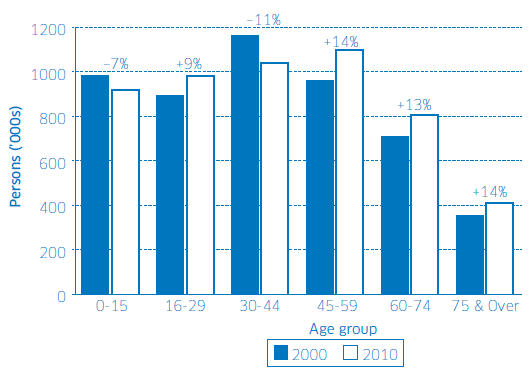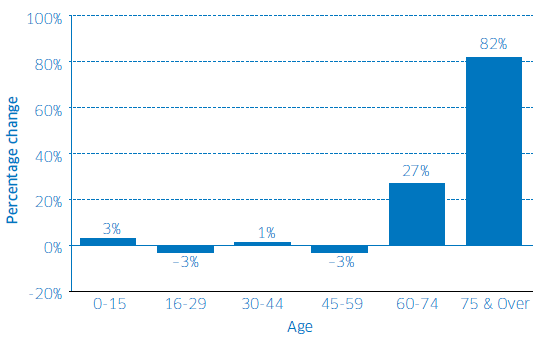Oral health improvement strategy for priority groups
Strategy targeted at those vulnerable to poor oral health including frail older people, those with special care needs and homeless people.
Chapter Two Demography
This chapter looks at changes over time in the number of people in each of the priority groups; older people and those who have special care needs, and people who are homeless.
2.1 Population Trends: Scotland
On June 30th 2010, the estimated population of Scotland was 5,222,100, the highest recorded since 1977. The greatest increase was seen in older age groups. A 14% increase was observed in those aged 75 and over. (Figure 1). Similar growth was seen in the 45-59 age group, a factor which will continue to feed growth in the population of older people over the next 30 years.
Figure 1. The changing age structure of Scotland's population, 2000-2010

Source: http://www.gro-scotland.gov.uk/statistics/theme/population/index.html
Trend data indicate that the number of older people in Scotland will continue to rise in future, outpacing other population groups. Based on 2010 estimates, it is predicted that by 2020 the number of people of pensionable age will grow by 3%, rising more rapidly thereafter, to reach 1.32 million by 2035. This represents a 26% rise from 2010 figures. The number of people aged 75 and over is also projected to rise, by 82% from 2010 levels (Figure 2), reaching 0.74 million in 2035.15
Figure 2. The projected percentage change in Scotland's population by age group, 2010-2035

2.2 Population Trends: The Dental Priority Groups
2.2.1 Adults Living with a Disability, Health Problem or Long-term Condition
It has been estimated that 952,500 (18.5%) of people in households in Scotland have a long-standing illness, health problem, or a disability.16 Conditions include: blindness or severe visual impairment, deafness, physical disability, mental health problems, learning disability or chronic illness. The proportion affected has remained steady over the past 10 years and is very similar to the number of people reported to be suffering from such conditions in the 2001 Census (20%).
People Cared for within the Care Home Setting
The 2010 Scottish Care Home Census17 identifies the number of people cared for within the care home setting.
- At March 2010 there were 38,042 residents being looked after in 1,375 registered care homes; 33,941 people were accommodated in care homes for older people, and 545 residents were accommodated in care homes for physically disabled people. Eighty-two care homes provided care for 1,063 adults with mental health problems and a further 2,214 adults were looked after in care homes for adults with learning disabilities.
- A further 279 people were cared for in accommodation for adults with brain injury, alcohol- and drug-related problems. A number of people with HIV and AIDS and mothers and babies were also accommodated in this setting.
The Scottish Dental Needs Assessment Programme (SDNAP) recently highlighted the changing nature of the population of people looked after in the care home setting as changes in national policy encouraged people to remain in their own homes for as long as possible. Those entering care homes are commonly frailer and more vulnerable than was previously the case.18
People Cared for at Home
As of the last week in March 2010, there were 66,222 people identified as people receiving care at home. The number has declined over the last three years.17 Table 1 sets out the profile of this client group.
Table 1. Age, Client Group and Gender of Clients Receiving Home Care Services, 2010
| Client Group | Age Groups | Total | ||||
|---|---|---|---|---|---|---|
| 0-64 | 65-74 | 75-84 | 85+ | Unknown | ||
| Older people | 84 | 4,193 | 12,560 | 12,716 | 7 | 29,560 |
| People with dementia | 108 | 400 | 1,621 | 1,381 | 0 | 3,510 |
| People with mental health problems | 1,733 | 641 | 568 | 295 | 2 | 3,239 |
| People with learning disabilities | 3,487 | 420 | 179 | 26 | 0 | 4,112 |
| People with physical disabilities | 5,072 | 3,729 | 6,902 | 6,866 | 1 | 22,570 |
| People with addiction problems | 272 | 192 | 84 | 16 | 1 | 565 |
| Palliative care | 60 | 49 | 79 | 38 | 0 | 226 |
| Carer | 60 | 18 | 35 | 21 | 0 | 134 |
| People in other vulnerable groups | 916 | 178 | 185 | 177 | 0 | 1,456 |
| Not known | 757 | 15 | 38 | 38 | 2 | 850 |
| Male | 6,106 | 4,067 | 6,833 | 4,980 | 7 | 21,993 |
| Female | 6,443 | 5,768 | 15,418 | 16,594 | 6 | 44,229 |
| Total clients | 12,549 | 9,835 | 22,251 | 21,574 | 13 | 66,222 |
Source: Home Care Statistical Return
All figures relate to the last week in March (that is the week which includes 24 March 2010).
To assist independent living for as long as possible, local authorities provide home care which includes personal care services, such as oral hygiene services for those with assessed need.18
2.2.2 People who are Homeless
An estimated 55,227 applications were made to local authorities under the Homeless Persons Legislation in 2010-11, a 3% decrease compared to 2009-10.19
People experiencing homelessness include:
- Roofless people: rough sleepers, victims of fire or flood, newly arrived immigrants.
- Houseless people: those living in emergency or temporary accommodation provided for homeless people: night shelters, hostels, refuges.
- People staying in bed and breakfast accommodation unsuitable for long stay as they have no other accommodation.
- People staying in institutions because they have nowhere else to stay.
- People facing eviction.
- People with insecure tenure.
- Squatters and young people who have been asked to leave the family home.
- People with short-term permission to stay with friends or relatives.
- People sharing housing in unreasonable circumstances.
The majority of households applying under legislation were single-person households (61%, and predominantly male). Single parents, mainly women, accounted for the next largest group (24%).19 However, the true number of people experiencing homelessness remains unknown.
Contact
Email: Tom Ferris
There is a problem
Thanks for your feedback